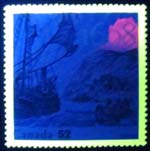
|
Elizabethan II Study Group Journal: The Corgi Times Glossary |
S | |||||||||||||||||||||||||||||
| SASE - acronym for Self Addressed Stamped Envelope. An unused envelope bearing the address of the sender and return postage. Sent to make answering a query more easy. | |||||||||||||||||||||||||||||
| Scott Publishing - the leading catalogue published in the United States whose numbering system is unarguably the most popular in North America. |
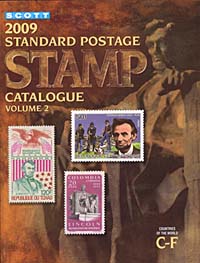 |
||||||||||||||||||||||||||||
| Scoreline
- separation of coil rolls from early 1970's to late
1990's by
Canadian Bank Note such that "sticks" of 10
rolls 'adhere' together but be easily separated when
sold. If carefully opened, joined multiples could be made that would look "imperforate between" errors. These are normal production varieties. |
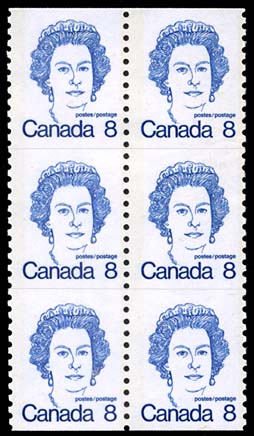 Scoreline (horizontal, between stamps) |
||||||||||||||||||||||||||||
| s.e. - abbreviation for straight edge (see below), denoting stamps with one (or more) imperforate edge(s). | |||||||||||||||||||||||||||||
Security
features - items incorporated into the design or
printing of a stamp to guard against
counterfeiting. These could include:
|
 "Hidden" text
|
||||||||||||||||||||||||||||
| Self
adhesive - a stamp with pressure sensitive
adhesive (PSA) gum. Over the last decade more and
more stamps are being issued in a self adhesive
format. See PVA gum. |
|||||||||||||||||||||||||||||
| Selvedge (selvage) - the unprinted marginal paper on a sheet or pane of stamps. |
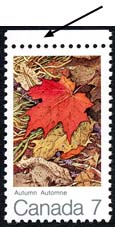 Selvedge |
||||||||||||||||||||||||||||
| Semi-postal - a 'charity' stamp containing an extra surcharge as part of its selling price. This small portion was a means of collecting funds for a specified event. Canada has 13 semi-postal stamps. The first 12 were used to help raise funds for the 1976 Montreal Olympics. One other semi-postal was issued in 1996 to collect money for literacy. |
 Semi-postal
| ||||||||||||||||||||||||||||
| Separation - the actual separation of individual copies from a mint sheet of modern perforated stamps is correctly done by first folding and firmly creasing along the line of perfs to break the remaining paper fibres in the 'teeth'. | |||||||||||||||||||||||||||||
| Series - a group of stamps with a similar design or theme. A series may be planned or may evolve. | |||||||||||||||||||||||||||||
|
Serpentine die cut - simulated
perforation
die cutting
applied to self-adhesive
stamps. Click for an extensive article on Lowe-Martin's serpentine die cutting. |
 Serpentine die cut |
||||||||||||||||||||||||||||
| Se-tenant - joined together (French); term applied to two or more unseparated different stamps. |
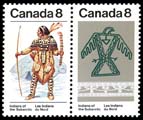 Se-tenant (pair) |
||||||||||||||||||||||||||||
| Set - a set of stamps is a sequence or series of values of like type issued at one time or within a period. | |||||||||||||||||||||||||||||
| Shade - denotes the nuance or tone gradation in a particular basic or pure colour. Strictly speaking, a shade is a degraded or darkened pure colour. A lightened colour or a colour plus white is more correctly a 'tint'. | |||||||||||||||||||||||||||||
| Sheet - the maximum number of stamps printed on one sheet f paper as it comes from the press. Sometimes they are divided into two or four sub-sheets or panes before distribution to post offices. | |||||||||||||||||||||||||||||
| Short set - a set of stamps complete to a specified value only, usually excluding the higher and more expensive values. | |||||||||||||||||||||||||||||
| Show cover - |
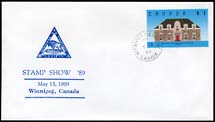 Show cover |
||||||||||||||||||||||||||||
| Slater -
a manufacturer of paper used on Elizabethan-era
stamps. First seen in October 1988. The gum is a light cream-coloured. |
 Inscription showing 'S' for Slater paper |
||||||||||||||||||||||||||||
| Sleeper - a stamp or other collectible item that seems to be underpriced and may have good investment potential. | |||||||||||||||||||||||||||||
| Sleeve - a seamless cylindrical printing plate used in rotary intaglio printing. | |||||||||||||||||||||||||||||
| Slogan - the brief sentence incorporated in modern machine postmarks/cancellations, such as 'Post Early for Xmas'. |
 Slogan cancel |
||||||||||||||||||||||||||||
| Soaking off - the removal of surplus adhering paper from used postage stamps by immersion in plain water. | |||||||||||||||||||||||||||||
| 'Socked on the nose' - a stamp with a centred, legible, and full town and date cancel. See CDS. |
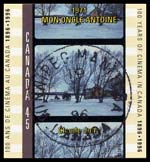 Sock-on-the-nose cancel |
||||||||||||||||||||||||||||
| Souvenir card - a philatelic card, not valid for postage, issued in conjunction with some special event. |
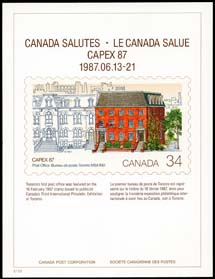 Souvenir Card |
||||||||||||||||||||||||||||
| Souvenir sheet - as miniature sheet, but implying some form of commemorative inscription in the sheet margin, and also including certain items of philatelic interest. |
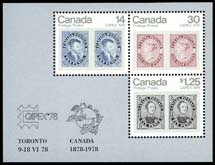 Souvenir Sheet |
||||||||||||||||||||||||||||
| Space-filler - a stamp not perhaps of the highest quality, but sound and presentable enough to warrant inclusion in a collection. | |||||||||||||||||||||||||||||
| Spandrel - the corner between the central or inner oval, circle, or other frame (not a rectangle), and the outer or main border of the design. | |||||||||||||||||||||||||||||
| Special Delivery - |
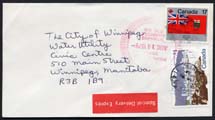 Special Delivery |
||||||||||||||||||||||||||||
| Specialist - an advanced and experienced collector who has made an intensive study of the stamps in which he specializes, usually extending to postal history, essays and proofs, covers, varieties, and so on.
One is not automatically a specialist in Canada if it happens that one collects only Canadian stamps! |
|||||||||||||||||||||||||||||
| Specimen - stamp or stationery item so overprinted for distribution to Universal Postal Union members for identification purposes and to the philatelic press and trade for publicity purposes. |
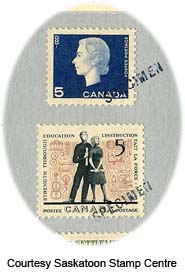 Specimen |
||||||||||||||||||||||||||||
| Speckled fluorescence - see flecked paper. | |||||||||||||||||||||||||||||
| Splice - the repair of a break in a roll of stamp paper, or the joining of two rolls of paper for continuous printing. Stamps printed over a splice are usually removed before the normal stamps are issued. | |||||||||||||||||||||||||||||
| Stamp - a postal adhesive. Initially used as a verb, meaning to imprint or impress, that is, to stamp a design. | |||||||||||||||||||||||||||||
| Stamp-on-stamp - a previously issued stamp illustrated within the design of another stamp. |
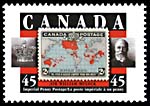 Stamp-on-stamp |
||||||||||||||||||||||||||||
| Start strip - The first group of stamps in a coil roll containing additional paper. Start strips on the early Elizabethan-era coils consisted of 10-15 blank 'stamps' with the word 'Start' printed at the end of the strip. The more recent self-adhesive rolls have a 5mm backing paper start that is taped to a clear plastic lining. Start strips are usually collected in strips of 4 stamps plus the complete starter strip. |
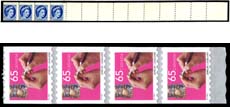 Start strips |
||||||||||||||||||||||||||||
| Steel engraving - see Line engraving. | |||||||||||||||||||||||||||||
| Step and repeat - a photographic method whereby multiple images are projected, or contact-printed, upon a sensitised plate, cliché, or film, so that each image is in exact relation to its neighbours to form a final printing surface for the production of sheets of stamps. | |||||||||||||||||||||||||||||
| Stock book - stock or duplicate books are obtainable in which loose stamps can be temporarily stored. |
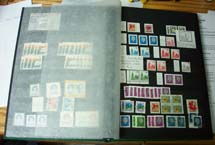 Stock book |
||||||||||||||||||||||||||||
| Straight edge - when the outer edge of a sheet of stamps is not perforated, marginal copies will have at least one straight edge - the corner copies having two, at right angles to each other.
Coils will typically have two opposite straight edges. Booklet stamps often have one or more straight edges due to trimming by the knife-guillotine in the final making up. Several Canadian issues printed by BABN from 1968-1970 included panes with one or two straight edges (as illustrated at right). |
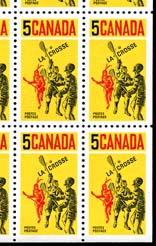 Straight edge (at right and bottom) [image is cropped] |
||||||||||||||||||||||||||||
| Strip - three or more unsevered stamps in a horizontal or vertical row. |
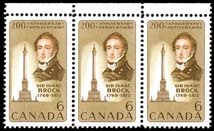 Strip (of 3) |
||||||||||||||||||||||||||||
| Study Group - a group of collectors who meet or correspond to advance their mutual interest in a particular group of stamps; virtually another name for a small specialized society. Meetings of study groups are frequently arranged in connection with philatelic shows or exhibitions. | |||||||||||||||||||||||||||||
| Surcharge - an overprint which alters the original face value of the stamp. |
 Surcharge |
||||||||||||||||||||||||||||
| Surtax - a value additional to the postal rate on a charity stamp (see Semi-postal). | |||||||||||||||||||||||||||||
|
© 2001-2017, 2018 Website design by: Adminware Corporation. For information or questions regarding this website, please contact Robin Harris |
